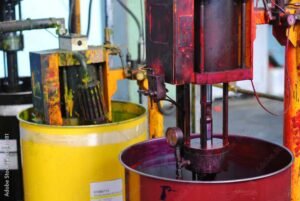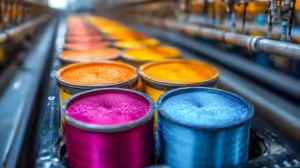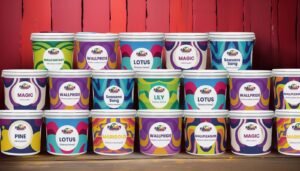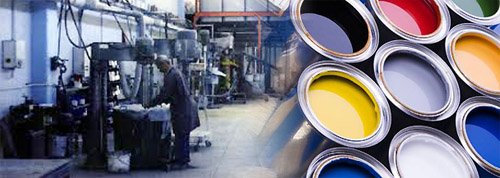Introduction to the Paint Factory Industry in Pune
The paint industry in Pune plays a vital role within the broader manufacturing sector, driving both economic growth and innovation in the region. Situated strategically in Maharashtra, Pune benefits from its proximity to Mumbai, which facilitates easy access to key markets and distribution channels. This location advantage not only enhances logistics but also attracts numerous businesses to establish their operations within the city, fostering a dynamic industrial ecosystem.
Pune boasts a diverse and skilled labor force, essential for the functioning of paint factories and their capacity to innovate. The presence of numerous educational institutions and training centers provides a continuous supply of qualified professionals, equipped with the necessary technical know-how. This availability of skilled labor enhances the operational efficiency of the paint industry, allowing for the development of high-quality products that meet both national and international standards. As a result, various companies specializing in mithila paints and other types of coatings have established their production facilities in and around Pune.
The growing demand for environmentally friendly and high-performance coating solutions has further propelled the growth of the paint industry in this region. Innovations in formulations and sustainable practices are becoming paramount, thus inviting investment into research and development initiatives. Local companies are increasingly focusing on producing water-based and low-VOC (volatile organic compound) paints, aligning with global trends toward sustainability. Pune’s paint factories are not just manufacturing entities; they are evolving into centers of excellence that emphasize eco-friendly practices while delivering diverse product lines. This proactive approach supports the industry’s reputation and maintains its competitive edge in the ever-evolving market landscape.

Historical Background of Paint Manufacturing in Pune
The origins of paint manufacturing in Pune trace back to the early 20th century, a period marked by industrial growth across India. The initial phases of this development involved small-scale production focused on local needs. Early manufacturers primarily used traditional methods to create natural pigments, which were blended with oils to formulate paints. This artisanal approach allowed for a diversity of vibrant colors, establishing a market for locally produced paints.
As the years progressed, Pune emerged as a significant hub for the paint industry, driven by both domestic demand and advancements in technology. The introduction of synthetic dyes and pigments in the mid-20th century marked a turning point. Manufacturers adapted by shifting towards more modern production processes, which not only enhanced the quality of the paints but also expanded their availability. The industry began to cater to a broader spectrum of customers, including construction firms and manufacturers requiring industrial coatings.
The establishment of major paint companies in the latter half of the century further solidified Pune’s reputation as a key player in the paint manufacturing sector. Notable firms began to innovate, investing in research and development to create more durable, eco-friendly, and aesthetically appealing products. These advancements led to the introduction of various specialized paints catering to different applications, including decorative paintings, residential and commercial use, and industrial coatings.
With the evolution of consumer preferences and a growing awareness of sustainability, the paint industry in Pune has increasingly embraced green technologies. This shift aligns with global trends and ensures that local manufacturers meet contemporary market demands. Today, the region continues to thrive as a pivotal center for the paint industry, with companies focusing on quality, innovation, and environmental responsibility. The rich history of paint manufacturing in Pune not only celebrates its past but also sets a solid foundation for future developments in mithila paints and related products.

Types of Paints Manufactured in Pune
The paint manufacturing industry in Pune presents a diverse array of products tailored to meet various market demands. The primary categories of paints produced in the region can be broadly classified into decorative, industrial, and specialty paints, each with distinct applications and properties. Understanding these categories is essential for recognizing the breadth of innovation and quality characterizing the local paint industry.
Decorative paints represent a significant portion of the market, primarily targeted towards residential and commercial spaces. These paints are designed to enhance aesthetic appeal and are available in a multitude of colors and finishes. They often include wall paints, enamel paints, and primers, catering to consumer preferences for texture and durability. The decorative paints produced in Pune are known for their rich pigments and eco-friendly formulations, addressing the growing demand for sustainable building materials. The increasing trend toward home improvement and renovation drives the ever-expanding local market for these vibrant mithila paints.
Industrial paints, another crucial category, are formulated to withstand harsh environments and demanding applications. These paints are typically used in manufacturing facilities, automotive industries, and machinery. Their properties often include high resistance to chemicals, corrosion, and extreme weather conditions. The industrial sector’s reliance on durable and reliable coatings underlines the significance of this segment in Pune’s paint manufacturing landscape. Companies continue to invest in R&D to develop advanced industrial paints that offer improved performance and longer-lasting protection.
Lastly, specialty paints encompass a wide range of unique products, such as anti-graffiti and heat-resistant paints, targeting specific needs across various sectors. Innovations in specialty paints often lead to the creation of solutions for niche markets and applications, further diversifying Pune’s paint industry offerings. As the demand for high-performance and specialized coatings grows, manufacturers are continuously exploring new technologies and formulations, thereby enhancing the overall quality of mithila paints available in the market.

Key Players in Pune’s Paint Manufacturing Sector
Pune’s paint manufacturing sector is notable for its diverse range of companies that contribute significantly to both the local economy and the broader Indian paint industry. Prominent players in this market include well-established brands and emerging companies that consistently innovate in product offerings and manufacturing practices. One of the key companies is Berger Paints, which has a strong presence in Pune, offering a wide array of products, including decorative and industrial paints. Their innovative approach to sustainability and eco-friendly products has garnered them a loyal customer base, enhancing their market share in the region.
Another significant player is Asian Paints, recognized nationally for its extensive range of high-quality paints and coatings. In Pune, Asian Paints maintains a robust distribution network, ensuring their products are readily available across various segments. The company has also introduced several advanced formulations that focus on durability and environmentally friendly solutions, catering to the rising consumer demand for sustainable options.
Further contributing to this vibrant industry are local manufacturers such as AkzoNobel and Nerolac. These companies not only provide general paints but also specialize in niche markets including automotive and marine coatings. AkzoNobel, for instance, is known for its innovative technologies that promote long-lasting finishes while minimizing environmental impact. Nerolac Paints has also made strides in creating paints that are resistant to weathering and pollution, thus adapting to the needs of customers in an urban setting like Pune.
The combined efforts of these key players not only illustrate the competitive nature of Pune’s paint manufacturing sector but also demonstrate their impact on the local economy. By employing innovative practices and focusing on customer needs, these companies contribute significantly to the growth and development of the manufacturing landscape in Pune, making it a crucial hub for mithila paints and other paint products.
Technological Advancements in Paint Production
The paint manufacturing industry in Pune is currently experiencing significant transformations due to technological advancements. One of the most notable developments is the increased implementation of automation within production processes. By incorporating automated systems, manufacturers can enhance efficiency, reduce labor costs, and improve quality control. Automation also allows for precise mixing and handling of raw materials, which is essential in creating innovative products, including mithila paints, that meet modern consumer demands.
In addition to automation, there has been a strong push towards sustainable practices in paint production. This shift is driven by a growing awareness of environmental concerns and the need for eco-friendly products. Many companies in Pune are now investing in green technologies that minimize waste and reduce harmful emissions during manufacturing. For instance, advancements such as water-based paints and low-VOC (volatile organic compounds) formulations are becoming more common. These innovations not only contribute to a cleaner environment but also align with the increasing consumer preference for sustainable alternatives in the market.
The future of the paint industry in Pune is further shaped by research and development aimed at creating advanced materials. Alongside traditional mithila paints, manufacturers are exploring novel ingredients and innovative binding agents that improve durability and finish quality. These custom formulations open up new avenues for artistic expression and functional applications, catering to a broad range of customers, from professional painters to DIY enthusiasts.
Moreover, the integration of digital technologies such as predictive analytics and machine learning is poised to revolutionize the paint production landscape. By analyzing consumer trends and preferences, manufacturers can optimize their product offerings to better meet market demands. Overall, the ongoing technological advancements in the paint production industry in Pune are not only enhancing operational efficiency but also promoting sustainability and creativity, thus crafting a dynamic future for mithila paints and other innovative products in the region.

Challenges Faced by Paint Factories in Pune
The paint factory industry in Pune encounters a myriad of challenges that can significantly affect production and overall growth. One of the foremost issues pertains to regulatory compliance. Paint manufacturers must navigate a complex landscape of government regulations that govern health, safety, and environmental standards. Failing to comply with these regulations can lead to severe penalties, including fines and operational shutdowns, which poses a considerable risk to ongoing operations and profitability.
Another substantial challenge is the increasing concern regarding environmental impact. As awareness around environmental preservation grows, paint factories in Pune are under pressure to adopt sustainable practices. This includes reducing volatile organic compounds (VOCs) in their products and implementing eco-friendly manufacturing processes. The transition toward more sustainable practices often entails significant upfront investment in technology and training, which can be a barrier for smaller manufacturers.
Moreover, competition in the paint industry is intensified as both local and international brands vie for market share. The influx of new entrants providing innovative products and marketing strategies compels existing factories to continually adapt or risk losing relevance. Established manufacturers must therefore invest in product development and marketing to differentiate their offerings. This competitive pressure can dilute profit margins, making it more challenging for factories to sustain profitability while also modifying their practices to meet new regulatory and consumer demands.
Furthermore, supply chain disruptions, particularly in the aftermath of global events, have posed additional logistical challenges for paint factories. The necessity for a reliable supply of raw materials is critical for maintaining consistent production levels, and any disruption can severely impact operations. As a result, paint factories must remain agile in their sourcing strategies to ensure they can respond effectively to these dynamic challenges.

Economic Impact of Pune’s Paint Factories
Pune’s paint manufacturing sector plays a pivotal role in the local economy, significantly contributing to job creation and the overall Gross Domestic Product (GDP) of the region. As one of the largest industrial hubs in India, Pune hosts a variety of paint factories that produce a diverse range of products, including residential and industrial paints, specialty coatings, and mithila paints. These factories not only cater to local demand but also supply their products to markets across the country and beyond, which in turn boosts the local economy.
The paint industry in Pune is a key employment generator, providing thousands of direct and indirect jobs. Direct employment is seen within the factories, where roles span from production staff to administrative positions. The indirect employment created extends to raw material suppliers, logistics providers, and service suppliers who support the paint manufacturing process. This job creation has been vital in curbing unemployment rates and enhancing the skill sets of the workforce, particularly within the manufacturing sector. Furthermore, as the industry expands, new opportunities continue to emerge, attracting skilled labor from various backgrounds.
Additionally, the contribution of Pune’s paint factories to the local GDP is notable. Paint manufacturing not only contributes tax revenues to the government but also fosters the growth of allied industries such as construction, automotive, and housing, creating a robust supply chain ecosystem. The demand for mithila paints, along with other diverse formulations, generates significant revenue and keeps local businesses thriving. As industrial standards evolve, Pune’s factories are also adopting sustainable practices, which not only meet regulatory requirements but also position them favorably in the global marketplace.
In summary, the economic impact of paint factories in Pune is multi-faceted, encompassing job creation, GDP contribution, and fostering a comprehensive supply chain that benefits various sectors, ultimately supporting the region’s economic growth.
Future Trends in Pune’s Paint Factory Industry
The paint factory industry in Pune is poised for significant transformation in the coming years, driven by evolving market dynamics and consumer preferences. As environmental concerns gain prominence, there is a noticeable shift towards sustainable and eco-friendly paint options. Consumers are increasingly seeking products that align with their values, leading to a surge in demand for mithila paints and similar alternatives. These sustainable solutions not only cater to the eco-conscious consumer but also promote responsible manufacturing practices.
Market predictions indicate a positive outlook for Pune’s paint factories, with technological advancements playing a crucial role in product innovation. Automation and the Internet of Things (IoT) are expected to revolutionize production processes, enhancing efficiency and reducing costs. Additionally, the incorporation of advanced manufacturing techniques, such as 3D printing for customized paint applications, is anticipated to create new business opportunities and serve niche markets. The trend toward personalization reflects a broader consumer desire for unique and tailored products, fostering creativity within the industry.
Moreover, the increasing focus on health and safety regulations is pushing manufacturers toward the formulation of paints that minimize volatile organic compounds (VOCs) and other harmful substances. Mithila paints, renowned for their natural ingredients, are likely to gain traction, catering to health-conscious consumers who prioritize indoor air quality and environmental safety. This shift will not only improve consumer satisfaction but will also align with regulatory frameworks aimed at reducing the environmental impact of industrial practices.
In conclusion, Pune’s paint factory industry is on the brink of significant changes, driven by sustainability, technology, and evolving consumer preferences. The synergy of these factors will likely create a vibrant landscape for innovation and growth, positioning Pune as a key player in the regional and national paint market.

Conclusion: The Role of Paint Factories in Pune’s Industrial Landscape
The paint factory industry in Pune plays a significant role in the region’s industrial landscape, contributing to economic development, innovation, and sustainability. With a history of manufacturing excellence, Pune has become a thriving hub for paint production, including renowned mithila paints. As the demand for high-quality, environmentally friendly coatings rises, paint factories have adapted their processes and offerings, showcasing their commitment to both consumer needs and sustainable practices.
The economic impact of paint factories is substantial. They create employment opportunities, not only in manufacturing roles but also in research and development, logistics, and management. This diversity of job creation enhances the local economy, empowering communities and fostering growth. By investing in advanced technologies and skilled personnel, paint factories ensure they remain competitive on both national and international scales.
Innovation is a cornerstone of the paint manufacturing sector in Pune. Companies continually explore new formulations and eco-friendly products to meet the evolving demands of consumers and regulations. The development of mithila paints, known for their vibrant colors and durability, exemplifies this innovative spirit, enabling the industry to cater to diverse markets, from residential to commercial applications.
Moreover, the sustainability initiatives undertaken by paint factories are commendable. Many companies prioritize minimizing their carbon footprint and adopting practices that conserve resources. Through responsible sourcing of raw materials and efficient production processes, they contribute towards a greener environment, aligning with global efforts to combat climate change.
In conclusion, the paint factories in Pune are indispensable to the city’s industrial framework. Their contributions to economic growth, commitment to innovation, and dedication to sustainability highlight the critical role they play in shaping not only local markets but also the broader manufacturing landscape across India.

